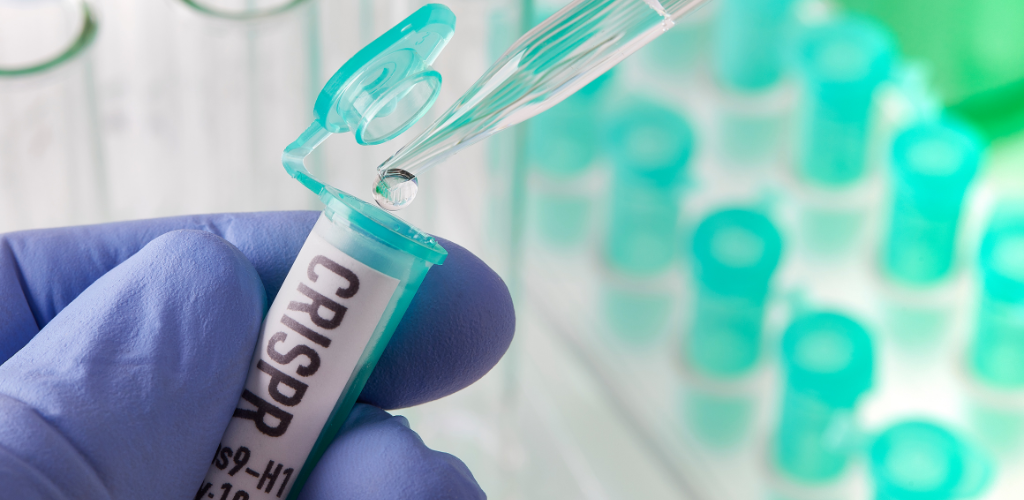The advent of CRISPR-Cas9 technology marked a pivotal moment in the field of genome editing, offering unprecedented precision and efficiency. However, as scientific research continues to evolve, several advancements have emerged, propelling genome editing capabilities beyond the confines of CRISPR-Cas9.
What is CRISPR-Cas9 and how does it work
CRISPR-Cas9 is a revolutionary genome editing tool that allows precise modification of an organism’s DNA. It consists of two key molecules: an enzyme called Cas9, which acts as a pair of “molecular scissors” that can cut the two strands of DNA at a specific location in the genome, and a piece of RNA called guide RNA (gRNA), which consists of a small pre-designed RNA sequence that guides Cas9 to the right part of the DNA. When the guide RNA recognizes the intended DNA sequence, the Cas9 enzyme cuts the DNA at the targeted location. Once the DNA is cut, the cell’s own DNA repair machinery can be used to add or delete pieces of genetic material, or to make changes to the DNA by replacing an existing segment with a customised DNA sequence.
CRISPR-Cas9 is faster, cheaper, and more accurate than previous techniques of editing DNA and has a wide range of potential applications. It is currently the simplest, most versatile, and precise method of genetic manipulation, causing a buzz in the science world. Beyond Cas9, other CRISPR-associated (Cas) proteins, such as Cas12 and Cas13, have been discovered and hold potential for various applications, including gene regulation, epigenome editing, and diagnostic tools.
The CRISPR defence mechanism protects bacteria from repeated viral attacks via three basic stages: adaptation (spacer acquisition), crRNA biogenesis, and interference. The CRISPR/Cas9 system in nature is used to protect prokaryotes from invading viruses by recognizing and cutting the target DNA. This technology has significant implications for research and therapeutics, and its future applications are being explored in various fields, including medicine and biotechnology.
What are the advantages of using CRISPR-Cas9 over other gene editing techniques
CRISPR-Cas9 offers several advantages over other gene editing techniques, making it a powerful tool in genetic research and potential therapeutic applications. Some of the key advantages include:
- Higher Gene-Editing Efficiency: CRISPR-Cas9 has a higher gene-editing efficiency compared to traditional gene-editing technologies such as TALEN and ZFN.
- Lower Off-Target Effects: It has lower off-target effects, meaning it is more precise in targeting the desired DNA sequences, reducing the likelihood of unintended genetic changes.
- No DNA Integration: Unlike some other methods, CRISPR-Cas9 does not lead to random integration of foreign DNA into the host genome, enhancing its safety and reducing the risk of disrupting normal gene function.
- Ease of Operation: CRISPR-Cas9 is relatively easy to design and use, making it more accessible to researchers.
- Flexibility and Multiplexing: It is easily programmable and allows for multiplexed genome editing, enabling the simultaneous modification of multiple genes.
- Cost-Effectiveness: CRISPR-Cas9 can be cost-effective relative to other gene editing approaches, which can require complex protein engineering.
These advantages have contributed to the widespread adoption of CRISPR-Cas9 in life science research and its potential for various applications in medicine, biotechnology, and beyond.
What are the potential risks and side effects of using CRISPR-Cas9
CRISPR-Cas9 is a powerful gene-editing tool, but it is not without potential risks and side effects. Some of the risks and side effects associated with CRISPR-Cas9 include:
- Off-Target Effects: CRISPR-Cas9 can sometimes cut DNA at unintended locations, leading to off-target effects and unintended genetic changes.
- On-Target Effects: CRISPR-Cas9 can also cause on-target effects, such as large genomic deletions and chromosomal rearrangements, which can lead to mutations and potential toxicity.
- Potential for Unwanted Changes: CRISPR-Cas9 can cause unwanted changes in human embryos, leading to the discard of large chunks of genetic material.
- Genotoxicity: CRISPR-Cas9 can induce adverse genomic events, including genotoxicity, which can be unpredictable and difficult to detect.
- Cancer Risk: CRISPR-Cas9 can occasionally cause large DNA insertions that could increase the risk of cancer.
Researchers are working to address these risks and side effects by developing new strategies to reduce off-target effects, improve precision, and enhance safety. Despite these challenges, CRISPR-Cas9 remains a promising tool for genetic research and potential therapeutic applications.
What are the potential risks and side effects of using CRISPR-Cas9
CRISPR-Cas9 is a powerful gene-editing tool, but it is not without potential risks and side effects. Some of the risks and side effects associated with CRISPR-Cas9 include:
- Off-Target Effects: CRISPR-Cas9 can sometimes cut DNA at unintended locations, leading to off-target effects and unintended genetic changes.
- On-Target Effects: CRISPR-Cas9 can also cause on-target effects, such as large genomic deletions and chromosomal rearrangements, which can lead to mutations and potential toxicity.
- Potential for Unwanted Changes: CRISPR-Cas9 can cause unwanted changes in human embryos, leading to the discard of large chunks of genetic material.
- Genotoxicity: CRISPR-Cas9 can induce adverse genomic events, including genotoxicity, which can be unpredictable and difficult to detect.
- Cancer Risk: CRISPR-Cas9 can occasionally cause large DNA insertions that could increase the risk of cancer.
Researchers are working to address these risks and side effects by developing new strategies to reduce off-target effects, improve precision, and enhance safety. Despite these challenges, CRISPR-Cas9 remains a promising tool for genetic research and potential therapeutic applications
Conclusion :
In conclusion, while CRISPR-Cas9 has revolutionised genome editing with its precision and versatility, it is not exempt from potential risks and side effects, including off-target effects and genotoxicity. Ongoing research aims to mitigate these challenges, ensuring CRISPR-Cas9’s continued promise in genetic research and therapeutic applications. The journey beyond CRISPR-Cas9 unveils a landscape of evolving technologies, each contributing to the intricate tapestry of genome editing advancements.
Citations:
[1] https://www.yourgenome.org/theme/what-is-crispr-cas9/
[3] https://www.ncbi.nlm.nih.gov/pmc/articles/PMC8388126/
[4] https://www.ncbi.nlm.nih.gov/pmc/articles/PMC4975809/
[5] https://medlineplus.gov/genetics/understanding/genomicresearch/genomeediting/
[6] https://www.ncbi.nlm.nih.gov/pmc/articles/PMC9478582/
[7] https://www.nytimes.com/2020/10/31/health/crispr-genetics-embryos.html
[8] https://www.ncbi.nlm.nih.gov/pmc/articles/PMC4975809/
[9] https://answers.childrenshospital.org/crispr-gene-editing/




